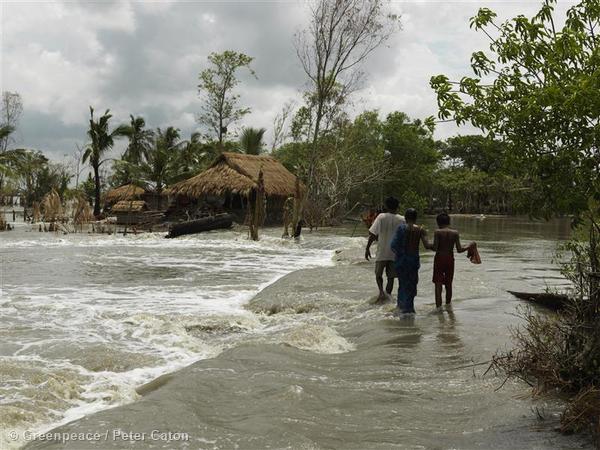Climate change, if left unchecked, will increase the likelihood of severe, pervasive and irreversible impacts on people and ecosystems. With these words, the world’s scientists have made an impassioned appeal to the world’s policymakers to combat what has been described as the challenge of our times.
Releasing the consolidated summary for policymakers of the fifth assessment report of the Intergovernmental Panel on Climate Change (IPCC), the scientists and economists also held out a ray of hope. “Options are available to adapt to climate change and implementing stringent mitigations activities can ensure that the impacts of climate change remain within a manageable range, creating a brighter and more sustainable future,” they said
The synthesis report released with the summary distils the findings of over 800 scientists and is the most comprehensive assessment of climate change undertaken yet. “Our assessment finds that the atmosphere and oceans have warmed, the amount of snow and ice has diminished, sea level has risen and the concentration of carbon dioxide has increased to a level unprecedented in at least the last 800,000 years,” said Thomas Stocker, Co-Chair of IPCC Working Group I [made up of climate scientists]
How South Asia will be affected
The report shows how climate change is particularly affecting key aspects of life in various parts of the world. It says this about South Asia:
- Over the mid-term (2046–2065), an increase of 2-4°C is projected for the region with the warmest temperatures concentrated in Iraq, Saudi Arabia, Iran, Russia, China, Mongolia, Nepal, and Bhutan.
- The warmest daily maximum temperature is projected to increase 4-7°C, with the highest temperature changes in Turkey, Iran, Iraq, Syria, northern India, Pakistan, China, Nepal, and Bhutan.
- The number of tropical nights (that is the number of nights above 20°C) is projected to significantly increase, with most concentrated in India, Thailand, portions of Myanmar, Laos, and portions of Vietnam. This extended period of heat can be problematic for human health.
- Overall, annual precipitation is projected to increase across eastern Asia, the Tibetan Plateau, and South and Southeast Asia.
- Over the mid-term (2046–2065) there is a 10 to 20% decrease of precipitation projected in March – May for portions of Southeast Asia and a 30% increase during September – November for China and Pakistan
- Cloudiness, which can amplify warming and humidity, which can affect human health are projected to increase over Pakistan and India.
- Annual mean soil moisture, which affects how well plants can grow, is projected to decrease across much of the western portion of the region (Turkey, Russia, Syria, Iraq, Iran), Nepal, Bhutan, China, Myanmar, Laos, Vietnam, Cambodia, Thailand and Malaysia while there are small increases projected for India, Pakistan, India, and Bangladesh.
- Annual runoff, that is the amount of water discharged from major rivers, is projected to decrease (-30% to -40%) across much of the already dry western portion of the region (Middle East) and increase (up to 40%) in some of the flood-prone regions, such as northern China, Pakistan, India, and in Southeast Asia.
- The impacts of climate change on food production and food security in Asia will vary by region, however, many regions are expected to see a decline in food productivity, with the largest numbers of food-insecure people located in South Asia.
- Fisheries, a major source of livelihoods and protein for many countries, are also projected to be negatively impacted by climate change, especially in South and Southeast Asia.
- The Indo-Gangetic Plains (India), which produce about 14-15% of global wheat, could suffer significant reductions due to climate change-induced heat stress, affecting about 200 million people (based on the current population).
- Warming temperatures may adversely affect rice and other crops growing near their heat stress limits in places such as Pakistan/North India (during October), South India (April, August), East India/Bangladesh (March-June), Myanmar/Thailand/Laos/Cambodia (March-June), Vietnam (April, August), Philippines (April, June), Indonesia (August) and China (July-August).
- Sea-level rise threatens coastal and deltaic rice production areas in Asia, such as those in Bangladesh, Myanmar, and the Mekong River Delta. For example, about 7% of Vietnam’s agricultural land may be submerged due to sea-level rise.
- Winter wheat yields could increase with warming temperatures in the northern portion of its production (northern Pakistan), however, extreme weather events could counter some of these gains.
- Climate change-induced floods also threaten vulnerable regions that have high concentrations of people and infrastructure, including many in India, Bangladesh, and China.
- By the 2070s, the top Asian cities with the most people at risk (including all environmental and socioeconomic factors) to coastal flooding are expected to be Kolkata, Mumbai, Dhaka, Guangzhou, Ho Chi Minh City, Shanghai, Bangkok, Rangoon, and Hai Phòng.
- Severe child stunting (lack of growth due to malnutrition) is projected to increase by 62% in South Asia due to climate change by 2050 without accelerated investment in planned adaptations.
- Permafrost is projected to decrease 20-90% by 2100 in North Asia and the Qinghai-Tibet Plateau, which will have substantial impacts to erosion, infrastructure, and livelihoods.
- Climate change may further complicate the unsustainable consumption of groundwater for irrigation and other uses in some locations, such as the Indian states of Rajasthan, Punjab, and Haryana.
- Climate change will challenge water supply issues in South Asia and may adversely affect agricultural and livestock sustainability.
Governments urged to act immediately
Reacting to the release of the report, UN Secretary General Ban Ki Moon said: “This Report offers three key messages: One: Human influence on the climate system is clear – and clearly growing. Second, we must act quickly and decisively if we want to avoid increasingly destructive outcomes. Three: We have the means to limit climate change and build a better future.”
“The report found that the world is largely very ill-prepared for the risks of a changing climate, especially the poor and most vulnerable who have contributed least to this problem.”
Samantha Smith, leader of WWF’s Global Climate & Energy Initiative, said, “The world’s best scientists have given us a good, clear measuring stick for what the world needs to do to combat rampant climate change. What the IPCC is really telling us is that we have an historic opportunity to secure a clean, just and safer future for the world and the people that live in it.”

